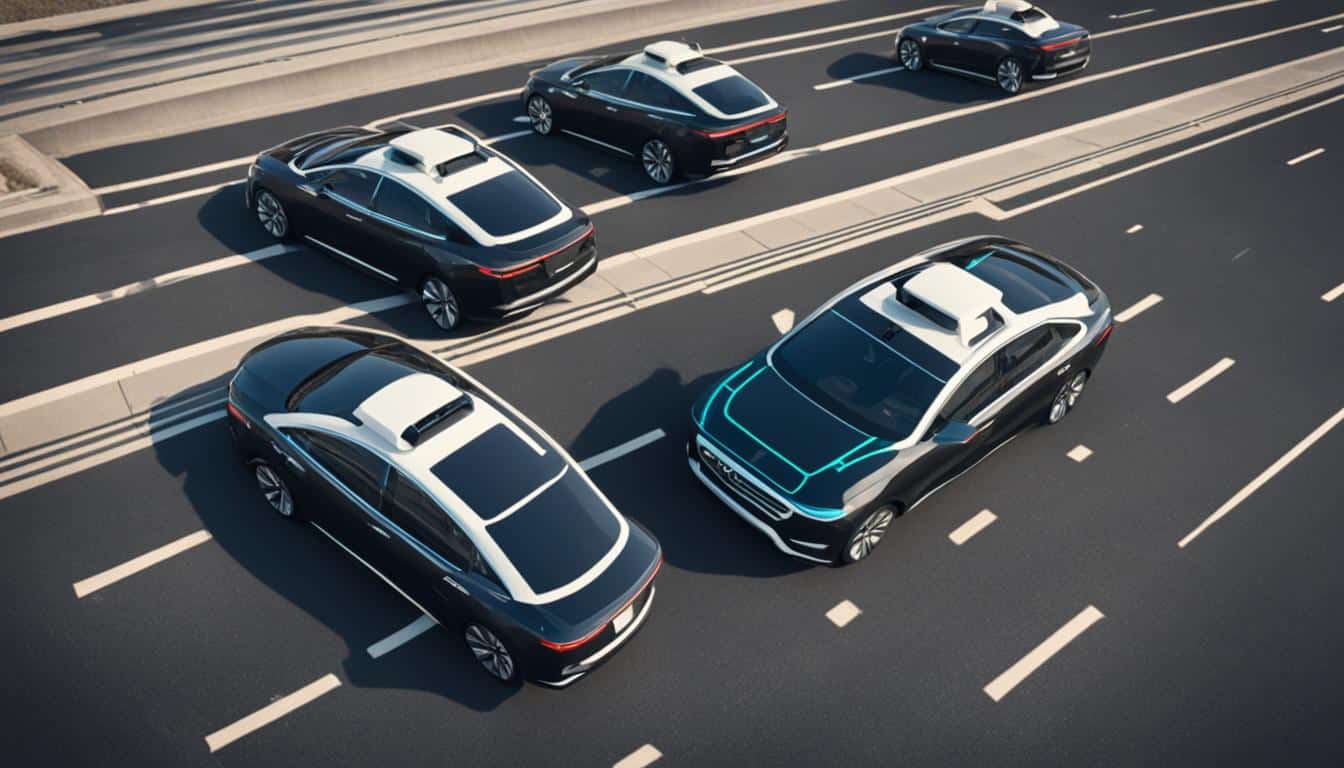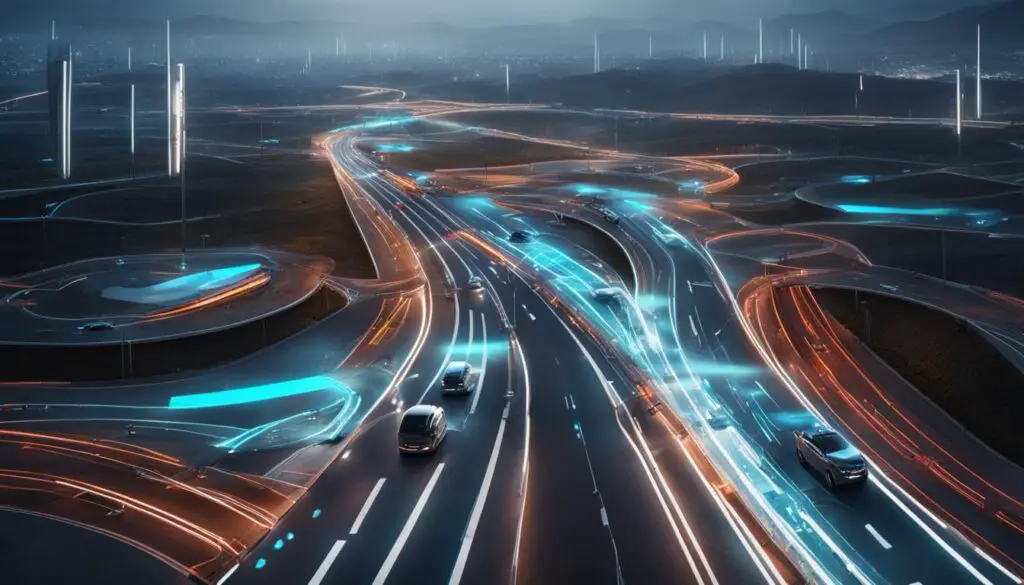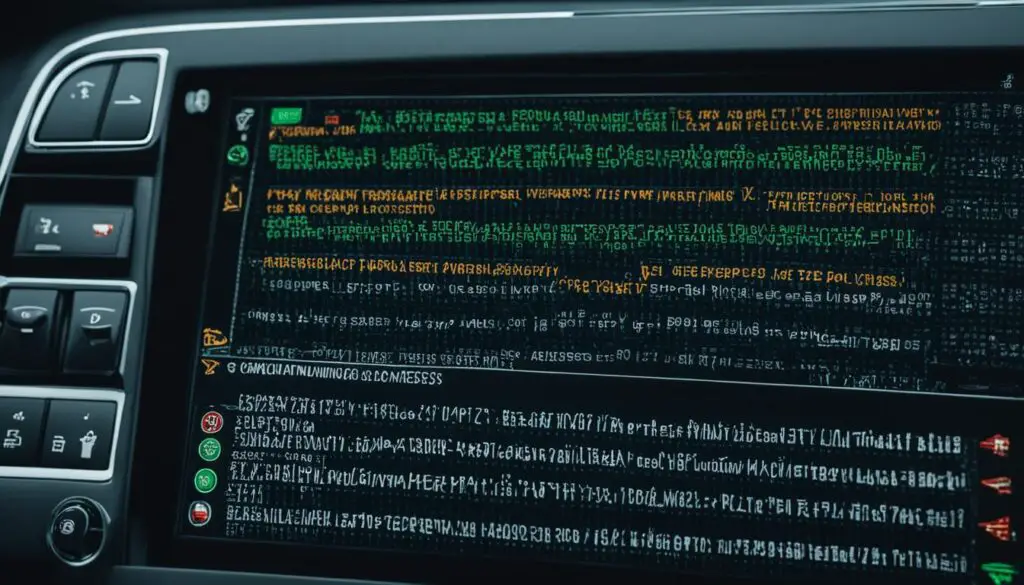
Vehicle-to-Vehicle Communication: The Future of Self-Driving Cars
Self-driving cars are rapidly becoming a reality, and one technology that is driving their advancement is Vehicle-to-Vehicle (V2V) communication. With V2V communication, cars can exchange vital information with each other in real-time, paving the way for a safer and more efficient transportation system. This technology holds the key to achieving the vision of zero automobile deaths and revolutionizing the future of transport.
V2V communication enables vehicles to transmit warnings and alerts to nearby cars, helping to prevent accidents before they happen. Companies like Tesla, Google, and Toyota are at the forefront of developing the necessary technology and infrastructure for V2V communication. As self-driving cars become more prevalent on our roads, the seamless exchange of data between vehicles will become essential for ensuring safe and reliable autonomous driving experiences.
Key Takeaways:
- V2V communication allows vehicles to transmit vital information to nearby cars in real-time.
- V2V communication technology aims to prevent accidents and improve road safety.
- Tesla, Google, and Toyota are actively working on optimizing V2V communication technology.
- V2V communication is a crucial step towards achieving zero automobile deaths.
- The future of self-driving cars relies on seamless communication between vehicles.
How Vehicle-to-Vehicle Communication Works
V2V communication enables vehicles to exchange real-time information with nearby cars, revolutionizing the future of self-driving cars. This technology leverages advanced wireless technologies and onboard sensors to facilitate seamless data transmission and enhance road safety.
Self-driving cars equipped with V2V communication systems can send and receive warnings and alerts to nearby vehicles. These warnings include crucial information such as collision avoidance alerts, speed limit notifications, and lane departure warnings. By sharing this information, self-driving cars can make informed decisions and adjust their behavior to avoid accidents.
The seamless flow of real-time data transmission between vehicles is made possible through the integration of advanced wireless technologies. These technologies enable vehicles to establish a reliable and secure communication network, allowing the exchange of vital information in milliseconds.
“V2V communication is a game-changer in self-driving car technology. By enabling cars to communicate with each other, we enhance safety, efficiency, and the overall driving experience.” – [Industry Expert]
Real-time data transmission in V2V communication not only improves road safety but also allows self-driving cars to optimize their performance and efficiency. By receiving real-time data about road conditions, traffic congestion, and potential hazards, self-driving cars can adjust their speed, trajectory, and driving behavior to ensure a smooth and efficient journey.
V2V communication is a crucial component of the future of self-driving cars, as it paves the way for fully autonomous driving. By enabling vehicles to exchange vital information in real-time, self-driving cars can navigate complex traffic scenarios and make informed decisions without human intervention.
The integration of V2V communication technology into self-driving cars holds great promise for the future of transportation. With continued advancements in wireless technologies and onboard sensors, the potential for enhanced road safety and efficient traffic management is immense.
| V2V Communication Benefits | Explanation |
|---|---|
| Improved Road Safety | V2V communication facilitates the exchange of real-time warnings and alerts, enabling vehicles to avoid accidents and drive safely. |
| Efficient Traffic Flow | Real-time data transmission allows self-driving cars to optimize their driving behavior and adjust their speed to ensure smooth traffic flow. |
| Enhanced Performance | V2V communication enables self-driving cars to receive real-time data about road conditions, traffic congestion, and hazards, optimizing their performance and efficiency. |
Benefits of Vehicle-to-Vehicle Communication
Vehicle-to-Vehicle (V2V) communication offers numerous benefits for drivers and the overall transportation system. Through V2V technology, cars can effectively communicate with each other, resulting in improved road safety, efficient traffic flow, and a more sustainable transport system.
Improved Road Safety
V2V communication plays a crucial role in enhancing road safety. By exchanging real-time information, vehicles can provide early warnings and alerts to drivers, helping to prevent accidents before they occur. For example, if one vehicle detects a potential collision, it can quickly transmit a warning signal to nearby cars, enabling them to react promptly and avoid a collision. This proactive approach supports the vision of reducing automobile fatalities and creating a safer driving environment.
Efficient Traffic Flow
In addition to improving road safety, V2V communication also enhances traffic flow and reduces congestion. By enabling vehicles to coordinate and adjust their speed and position based on shared information, traffic can be optimized to maximize efficiency. For instance, during heavy traffic, V2V communication allows cars to synchronize their movements, minimizing abrupt braking and accelerating, resulting in smoother traffic flow and reduced bottlenecks.
Green and Sustainable Transport
V2V communication contributes to a greener and more sustainable transport system. By optimizing traffic flow and reducing congestion, it helps to reduce fuel consumption and emissions. Through efficient coordination and planning, vehicles can avoid unnecessary idling and congestion-related stop-and-start driving, resulting in lower fuel consumption and a smaller carbon footprint. This technology aligns with the global effort to create environmentally friendly transportation solutions.
| Benefits of V2V Communication | Description |
|---|---|
| Increased Road Safety | Early warnings and alerts to prevent accidents |
| Efficient Traffic Flow | Coordinated speed and position adjustments for optimized traffic |
| Green and Sustainable Transport | Reduced fuel consumption and emissions |
V2V Communication Technologies
In the realm of vehicle-to-vehicle (V2V) communication, there are two primary technologies that are currently under consideration: IEEE 802.11p and Cellular V2X (C-V2X). Let’s take a closer look at each of these technologies and their capabilities.
IEEE 802.11p
IEEE 802.11p is a technology based on a Wi-Fi offshoot that utilizes the unlicensed 5.9GHz frequency band. This technology offers short-range, low-latency, and high-reliability communication, making it well-suited for various V2V and V2I (vehicle-to-infrastructure) use cases. With IEEE 802.11p, vehicles can exchange crucial safety-related information in real-time and enable proactive measures to avoid potential accidents.
Cellular V2X (C-V2X)
C-V2X, on the other hand, operates in both the unlicensed 5.9GHz band and the licensed-band cellular network. This technology provides a combination of direct and network-assisted communication, offering the capability to transmit short-range safety messages as well as longer-range infotainment and traffic condition updates. By leveraging the strengths of cellular networks, C-V2X enhances the overall communication capabilities between vehicles and enables a more comprehensive exchange of information.
“IEEE 802.11p and C-V2X are the two primary technologies driving the future of V2V communication.”
To help visualize the differences between these technologies, a table has been included below:
| Technology | Frequency Band | Communication Range | Key Features |
|---|---|---|---|
| IEEE 802.11p | 5.9GHz (unlicensed) | Short-range | – Low-latency communication – High reliability |
| Cellular V2X | 5.9GHz (unlicensed) and cellular-network | Short-range and longer-range | – Direct and network-assisted communication – Comprehensive information exchange |

Security Considerations for V2V Communication
While vehicle-to-vehicle (V2V) communication brings significant benefits to the future of self-driving cars, it also brings along potential security risks. It is crucial to prioritize data privacy and integrity to prevent disruptions and potential tampering.
In order to protect against security breaches, it is essential to implement robust security frameworks within the V2V communication system. One such measure involves separating the functionality to ensure the privacy of drivers while still allowing vehicles to transmit unique information.
The National Highway Traffic Safety Administration (NHTSA) and the Department of Transportation (DOT) are actively working together to establish safety standards and security frameworks that address these concerns. These efforts aim to create a secure and reliable communication network that protects the privacy of drivers and ensures the safe operation of self-driving cars.

Protecting Data Privacy
When it comes to V2V communication, safeguarding the privacy of transmitted data is of utmost importance. This entails implementing encryption techniques to prevent unauthorized access and ensuring the secure transfer of information between vehicles.
By utilizing robust encryption methods, sensitive data can be protected from potential cyber threats and unauthorized interceptions. This contributes to maintaining the trust of both drivers and passengers, fostering widespread adoption of V2V communication technology.
“Implementing encryption techniques and secure data transfer protocols is crucial to protect the privacy of drivers and passengers in V2V communication.”
Establishing Robust Security Frameworks
To combat the evolving landscape of cybersecurity threats, it is imperative to develop robust security frameworks specifically designed for V2V communication. These frameworks should encompass various layers of protection to ensure the integrity and authenticity of the transmitted data.
- Access Control: Implementing strict access control measures helps prevent unauthorized entities from tampering with the V2V communication system.
- Integrity Verification: Employing methods such as digital signatures and checksums enables the validation of data integrity, ensuring that transmitted information remains unaltered during transit.
- Behavior Monitoring: Implementing behavior monitoring techniques enables the detection of anomalies and potential security breaches in real-time, allowing for swift response and mitigation measures.
- Regular Updates: Keeping the security frameworks up to date with the latest advancements and patches is crucial to stay one step ahead of emerging threats.
By adopting these robust security frameworks, the V2V communication system can effectively counter prevailing security risks and safeguard the privacy of drivers and passengers.
Standardization and Implementation Challenges
Standardization plays a crucial role in the successful deployment of Vehicle-to-Vehicle (V2V) communication. It ensures interoperability and compatibility between different vehicles and communication systems, creating a cohesive network of connected cars. Currently, there are competing standards vying for prominence in the V2V landscape. One such standard is the IEEE 802.11p, which is currently the incumbent technology.
The IEEE 802.11p standard is based on a Wi-Fi offshoot and operates in the unlicensed 5.9GHz frequency band. It offers short-range communication with low latency and high reliability, making it suitable for a variety of V2V and V2I (Vehicle-to-Infrastructure) use cases.
Another contender in the field is Cellular V2X (C-V2X), which operates in both the unlicensed 5.9GHz band and the licensed-band cellular network. C-V2X combines direct communication between vehicles with network-assisted communication, providing both short-range safety messages and longer-range infotainment and traffic condition updates.
| V2V Communication Standards | Description |
|---|---|
| IEEE 802.11p | Wi-Fi-based standard operating in the 5.9GHz frequency band, offering short-range, low-latency, and high-reliability communication. |
| Cellular V2X (C-V2X) | Operates in both the unlicensed 5.9GHz band and the licensed-band cellular network, providing short-range and longer-range communication. |
While the selection of a standard is an important consideration, the successful implementation of V2V communication faces numerous challenges. One significant challenge is regulatory considerations. Governments and regulatory bodies need to establish guidelines and policies to govern the deployment and usage of V2V communication systems. These regulations should address issues such as spectrum allocation, data privacy, and security.
Securing public trust is another crucial challenge. The general public may have concerns about the privacy and security implications of V2V communication. Proper education and transparency are necessary to address these concerns and build trust in the technology.
Additionally, widespread adoption of V2V communication requires collaboration between industry stakeholders, government agencies, and regulatory bodies. It is essential to establish a cohesive framework that facilitates seamless integration of V2V communication systems into vehicles and infrastructure.
Deployment Challenges:
- Regulatory considerations for V2V communication implementation
- Building public trust in the technology and addressing privacy concerns
- Collaboration among industry stakeholders, government agencies, and regulatory bodies
Overcoming these challenges and establishing V2V communication standards and a comprehensive implementation framework will be key to unlocking the full potential of this transformative technology and shaping the future of self-driving cars.
Conclusion
Vehicle-to-Vehicle (V2V) communication is poised to revolutionize the future of self-driving cars. This groundbreaking technology allows cars to communicate with each other, unlocking a range of benefits that enhance safety, efficiency, and ultimately, pave the way for fully autonomous driving.
While there are challenges to overcome, such as standardization and security concerns, the potential advantages of V2V communication are substantial. By exchanging real-time information, vehicles can proactively avoid collisions, adhere to speed limits, and receive vital notifications, leading to a significant reduction in accidents.
The future of self-driving cars relies heavily on the continued research and development of V2V technology. With ongoing efforts in optimizing the necessary infrastructure, establishing robust security frameworks, and addressing standardization issues, V2V communication is shaping the future of transport. As this technology evolves, we move closer to achieving a safer and more connected driving experience for all.
FAQ
What is V2V communication?
V2V communication, or Vehicle-to-Vehicle communication, is a technology that enables vehicles to send and receive information to and from nearby cars in real-time. This allows self-driving cars to exchange vital data, such as collision warnings and speed limit notifications, to make informed decisions and avoid accidents.
How does V2V communication work?
V2V communication works by using advanced wireless technologies and onboard sensors. Vehicles transmit information, such as warnings and alerts, to nearby cars, which can then adjust their behavior to prevent accidents. This real-time data exchange enhances road safety and enables self-driving cars to operate more efficiently.
What are the benefits of V2V communication?
V2V communication offers numerous benefits for both drivers and the overall transportation system. It enhances road safety by providing early warnings and alerts, improves traffic flow by enabling vehicles to coordinate and adjust their speed and position, and reduces fuel consumption and emissions, contributing to a greener and more sustainable transport system.
What are the different V2V communication technologies?
There are two main V2V communication technologies currently being considered: IEEE 802.11p and Cellular V2X (C-V2X). IEEE 802.11p operates on a Wi-Fi offshoot and offers short-range, low-latency, and high-reliability communication. C-V2X operates in both the unlicensed 5.9GHz band and the licensed-band cellular network, providing a combination of short-range safety messages and longer-range infotainment and traffic updates.
What security considerations are there for V2V communication?
Ensuring the privacy and integrity of transmitted data is crucial for V2V communication. Robust security measures need to be in place to protect against security breaches and potential tampering. The National Highway Traffic Safety Administration (NHTSA) and the Department of Transportation (DOT) are actively working on safety standards and security frameworks to address these concerns.
Why is standardization important for V2V communication?
Standardization is critical for V2V communication as it ensures interoperability and compatibility between different vehicles and communication systems. Currently, there are competing standards, with IEEE 802.11p being the incumbent technology and C-V2X offering potential advantages. Collaboration between industry stakeholders, government agencies, and regulatory bodies is essential to establish a cohesive framework for V2V communication.
What is the future of V2V communication?
V2V communication is set to revolutionize the future of self-driving cars. It enhances safety, improves efficiency, and paves the way for fully autonomous driving. While there are challenges to overcome, such as standardization and security concerns, ongoing research and development will continue to evolve V2V technology and deliver a safer and more connected driving experience.
